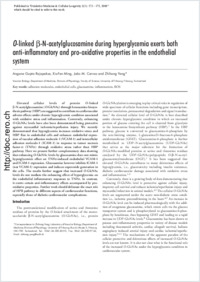O-linked β-N-acetylglucosamine during hyperglycemia exerts both anti-inflammatory and pro-oxidative properties in the endothelial system
- Rajapakse, Angana Gupta Vascular Biology, Division of Physiology, Department of Medicine, Faculty of Science, University of Fribourg, Switzerland
- Ming, Xiu-Fen Vascular Biology, Division of Physiology, Department of Medicine, Faculty of Science, University of Fribourg, Switzerland
- Carvas, João Miguel Vascular Biology, Division of Physiology, Department of Medicine, Faculty of Science, University of Fribourg, Switzerland
- Yang, Zhihong Vascular Biology, Division of Physiology, Department of Medicine, Faculty of Science, University of Fribourg, Switzerland
-
2009
Published in:
- Oxidative Medicine & Cellular Longevity. - 2009, vol. 2, no. 3, p. 172-175
English
Elevated cellular levels of protein O-linked β-N-acetylglucosamine (O-GlcNAc) through hexosamine biosynthesis pathway (HBP) are suggested to contribute to cardiovascular adverse effects under chronic hyperglycemic condition associated with oxidative stress and inflammation. Conversely, enhancing O- GlcNAc levels have also been demonstrated being protective against myocardial ischemia/reperfusion injury. We recently demonstrated that hyperglycemia increases oxidative stress and HBP flux in endothelial cells and enhances endothelial expression of vascular adhesion molecule-1 (VCAM-1) and intercellular adhesion molecule-1 (ICAM-1) in response to tumor necrosis factor- α (TNF-α) through oxidative stress rather than HBP pathway. Here we present further complementary data showing that enhancing O-GlcNAc levels by glucosamine does not mimic hyperglycemia’s effect on TNF-α−induced endothelial VCAM-1 and ICAM-1 expression. Glucosamine however inhibits ICAM-1 (not VCAM-1) expression and induces superoxide generation in the cells. The results further suggest that increased O-GlcNAc levels do not mediate the enhancing effect of hyperglycemia on the endothelial inflammatory responses to TNF-α. In contrast, it exerts certain anti-inflammatory effects accompanied by pro-oxidative properties. Further work should delineate the exact role of HPB pathway in different aspects of cardiovascular functions, especially those of diabetic cardiovascular complications.
- Faculty
- Faculté des sciences et de médecine
- Department
- Département de Médecine
- Language
-
- English
- Classification
- Biological sciences
- License
-
License undefined
- Identifiers
-
- RERO DOC 17044
- DOI 10.4161/oxim.2.3.8482
- Persistent URL
- https://folia.unifr.ch/unifr/documents/301432
Statistics
Document views: 228
File downloads:
- pdf: 237
